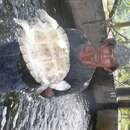Lifespan, longevity, and ageing
provided by AnAge articles
Maximum longevity: 25.3 years (captivity)
- license
- cc-by-3.0
- copyright
- Joao Pedro de Magalhaes
- editor
- de Magalhaes, J. P.
Biology
provided by Arkive
The giant South American turtle nests during the low water season, laying from 75 to 125 leathery eggs per clutch. Large groups of females return to the same sandy riverbanks and sandbars every year to nest in groups that are thought to decrease loss of eggs to predators due to the shear numbers present (8). The eggs take from 42 to 47 days to hatch (3), timed to avoid the rising of the rivers which will drown any unhatched turtles (8). As with most turtles, the sex of the hatchlings is determined by the average temperature at which they are incubated – females develop at higher temperatures and males develop at lower temperatures (3).
This species is mainly herbivorous, feeding on aquatic vegetation and plant matter that falls into the water. However, it is also known to be somewhat opportunistic, feeding on small, slow-moving prey and carrion (3).
Mutual cleaning behaviour between individuals of this species has been observed. One turtle will position itself at right angles to a second turtle and use its jaws to pull algae from its shell. The turtles will then switch position (2).
Conservation
provided by Arkive
With high reproductive potential, the giant South American turtle is expected to be capable of rapid recovery in areas with limited human presence and an environmental management plan. The management plan implemented at Middle Orinoco River has included the protection of nesting beaches, a nursery program for the care and release of hatchlings, and an environmental education program for the public. It has resulted in the slowed decline of nesting turtles and a modest increase in total turtle numbers since 1992 (9). In addition, research has showed that eggs in a clutch laid by one mother may have different fathers, which helps to increase genetic variation and reduces the prevalence of inbreeding defects that result from small populations (11)
Description
provided by Arkive
The giant South American turtle is the largest river turtle in South America (7). It has a broad, domed and streamlined carapace for active swimming in moderate river currents (3). The colour may be influenced by the algae that is attached to it (2), but is usually olive green to brown in colour (5). This turtle belongs in the family Pelomedusidae, which contains the side-necked turtles, and has a long neck which can be withdrawn horizontally within the shell, leaving it partly exposed, rather than retracting it in a vertical 'S' bend as in most other turtles (3).
Habitat
provided by Arkive
The giant South American turtle inhabits freshwater rivers with sandy banks or sandbars, which are crucial for nesting (3).
Range
provided by Arkive
This turtle is found in the Amazon River drainages of South America, as far south as northern Brazil and northern Peru and as far west as eastern Peru. It is also found on the Islands of Trinidad and Tobago (1) (6).
Status
provided by Arkive
The giant South American turtle is classified as Lower Risk – conservation dependent (LR/cd) on the IUCN Red List 2003 (1) and is listed under Appendix II of CITES (3).
Threats
provided by Arkive
Threats to this species include poaching of females, collection of eggs and hatchlings, accidental and intentional capture (for food and oil) of adult turtles by fishermen, urban and industrial development near nesting sites, and lack of conservation education (9). Logging and clearing of areas surrounding rivers and damming of rivers can cause the water cycle to be drastically altered. This can confuse the turtles' natural seasonal cycle of nesting which is timed to the alternation of floods and low flows. In addition, premature rising of rivers can flood nesting sites causing reduced hatching success (8).
Climate change can potentially threaten turtle species as the sex of offspring is determined by the temperature at which they are incubated. Should the temperature rise 2 ºC, the ratio of males to females could be severely skewed, and a rapid rise of 4 ºC could possibly eliminate males altogether. Turtles are seen as indicator species that can reveal the effects of climate change on the natural world (10).
Distribution
provided by ReptileDB
Continent: South-America
Distribution: Caribbean drainages of Guyana and Venezuela, upper Amazon tributaries in Bolivia, Peru, Colombia, Venezuela, and Brazil, Ecuador, Trinidad.
Type locality: South America.

